Justicia (plant)
Justicia is a genus of flowering plants in the family Acanthaceae. It is the largest genus within the family, encompassing around 700[3] species with hundreds more as yet unresolved.[4] They are native to tropical to warm temperate regions of the Americas, India and Africa. The genus serves as host to many butterfly species, such as Anartia fatima. Common names include water-willow and shrimp plant, the latter from the inflorescences, which resemble a shrimp in some species. The generic name honours Scottish horticulturist James Justice (1698–1763).[5] They are closely related to Pachystachys.[6]
| Justicia | |
|---|---|
 | |
| Justicia magnifica | |
| Scientific classification | |
| Kingdom: | Plantae |
| Clade: | Tracheophytes |
| Clade: | Angiosperms |
| Clade: | Eudicots |
| Clade: | Asterids |
| Order: | Lamiales |
| Family: | Acanthaceae |
| Subfamily: | Acanthoideae |
| Tribe: | Justicieae |
| Genus: | Justicia L.[1] |
| Species | |
|
Over 900, see List of Justicia species | |
| Synonyms[2] | |
|
List
| |
Description
They are evergreen perennials and shrubs with leaves which are often strongly veined; but they are primarily cultivated for their showy tubular flowers in shades of white, cream, yellow, orange or pink. Excepting Justicia americana L., they are not hardy below 7 °C (45 °F), so may be grown under glass in frost-prone areas.[6]
Species
Selected species include:
- Justicia adhatoda L.
- Justicia aequalis Benoist
- Justicia alexandri R.Atk.
- Justicia americana L.
- Justicia andrographioides C.B.Clarke
- Justicia angustifolia Nees
- Justicia aurea Schltdl.
- Justicia austroguangxiensis H.S.Lo & D.Fang
- Justicia bitarkarae Gómez-Laur.
- Justicia brandegeeana Wassh. & L.B.Sm.
- Justicia burchellii Hiern
- Justicia californica (Benth.) D.N.Gibson
- Justicia calliantha Leonard
- Justicia camerunensis (Heine) I.Darbysh.
- Justicia cardiophylla D.Fang & H.S.Lo
- Justicia carnea Lindl.
- Justicia chimalapensis T.F.Daniel
- Justicia chrysotrichoma (Nees) Benth. & Hook.f.
- Justicia clausseniana (Nees) Profice
- Justicia cooleyi Monach. & Leonard
- Justicia cyanea Leonard
- Justicia daidalea Leonard
- Justicia flaviflora (Turrill) Wassh.
- Justicia floribunda (K.Koch) Wassh.
- Justicia galapagana Lindau ex B.L.Rob.
- Justicia gendarussa Burm.f.
- Justicia genistiformis Nees
- Justicia hatschbachii (Rizzini) Wassh. & L.B.Sm.
- Justicia ianthina Wassh.
- Justicia irwinii Wassh.
- Justicia japonica Thunb.
- Justicia kasamae Vollesen
- Justicia lamprophylla Leonard
- Justicia lanstyakii Rizzini
- Justicia leucoxiphos Vollesen, Cheek & Ghogue
- Justicia longii Hilsenb.
- Justicia magdalenensis J.R.I.Wood
- Justicia nervata (Lindau) Profice
- Justicia nodicaulis (Nees) Leonard
- Justicia nuriana Wassh.
- Justicia oncodes (Lindau) Wassh. & C.Ezcurra
- Justicia orbicularis (Lindau) V.A.W.Graham
- Justicia pectoralis Jacq.
- Justicia petiolaris E.Mey.
- Justicia petraea Leonard
- Justicia polita (Nees) Profice
- Justicia procumbens L.
- Justicia pycnophylla Lindau
- Justicia rigida Balf.f.
- Justicia riojana Lindau
- Justicia riopalenquensis Wassh.
- Justicia riparia Kameyama
- Justicia romba Benoist
- Justicia sarithroides Lindau
- Justicia serrana Kameyama
- Justicia spicigera Schltdl.
- Justicia suarezensis Benoist
- Justicia takhinensis R.Atk.
- Justicia tobagensis (Urb.) Wassh.
- Justicia tocantina (Nees) V.A.W.Graham
- Justicia uber C.B.Clarke
- Justicia venalis Benoist
- Justicia warmingii Hiern
- Justicia wilhelminensis Wassh.
- Justicia xylosteoides Griseb.
- Justicia zarucchii Wassh.
Justicia brandegeeana (formerly Beloperone guttata, commonly called shrimp plant) is native to Mexico. It is hardy to −4 °C but will often recover in the spring after freezing back in USDA Plant Zone 8a.
Justicia carnea (formerly Jacobinia carnea, common names including Brazilian plume flower, flamingo flower, and jacobinia) is native to South America in southern Brazil, Paraguay and northern Argentina. It is hardy to −2 °C but will often recover in the spring after freezing back in USDA Plant Zone 8a.
Justicia procumbens is procumbent herb with angular stems, swollen at nodes, small ovate leaves, small purple flowers in terminal spikes, inserted didynamous stamens, and shortly bilobed stigmas.
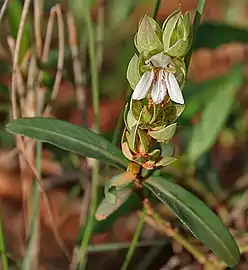
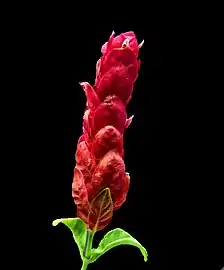
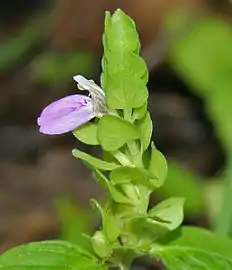 Justicia glauca in Hyderabad, India.
Justicia glauca in Hyderabad, India.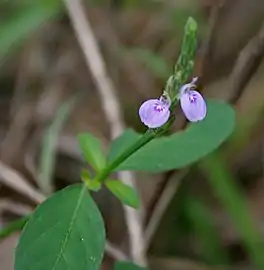 Justicia procumbens var. simplex near Talakona forest, in Chittoor District of Andhra Pradesh, India.
Justicia procumbens var. simplex near Talakona forest, in Chittoor District of Andhra Pradesh, India.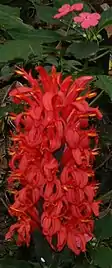
References
- "Genus: Justicia L." Germplasm Resources Information Network. United States Department of Agriculture. 2009-01-23. Archived from the original on 2015-09-24. Retrieved 2010-05-26.
- "Justicia L." Plants of the World Online. Board of Trustees of the Royal Botanic Gardens, Kew. 2017. Retrieved 9 July 2020.
- Daniel, Thomas F. (2011). "JUSTICIA (ACANTHACEAE) IN TEXAS". Journal of the Botanical Research Institute of Texas. 5 (2): 595–618. JSTOR 41972309.
- "Justicia — the Plant List".
- Austin, Daniel F. (2004). Florida Ethnobotany. CRC Press. p. 381. ISBN 978-0-8493-2332-4.
- RHS A-Z encyclopedia of garden plants. United Kingdom: Dorling Kindersley. 2008. p. 1136. ISBN 978-1405332965.
External links
![]() Media related to Justicia at Wikimedia Commons
Media related to Justicia at Wikimedia Commons
- Dressler, S.; Schmidt, M. & Zizka, G. (2014). "Justicia". African plants – a Photo Guide. Frankfurt/Main: Forschungsinstitut Senckenberg.
